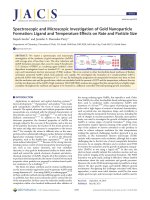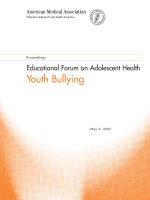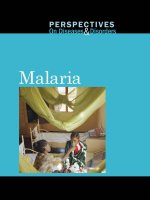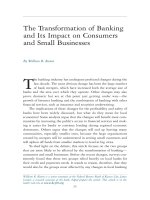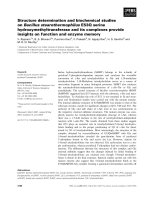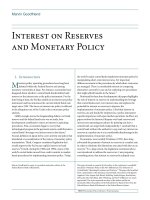Neighborhood Effects on Crime and Youth Violence doc
Bạn đang xem bản rút gọn của tài liệu. Xem và tải ngay bản đầy đủ của tài liệu tại đây (1.15 MB, 139 trang )
This document and trademark(s) contained herein are protected by law as indicated in a notice appearing later in
this work. This electronic representation of RAND intellectual property is provided for non-commercial use only.
Unauthorized posting of RAND PDFs to a non-RAND Web site is prohibited. RAND PDFs are protected under
copyright law. Permission is required from RAND to reproduce, or reuse in another form, any of our research
documents for commercial use. For information on reprint and linking permissions, please see RAND Permissions.
Limited Electronic Distribution Rights
This PDF document was made available from www.rand.org as a public
service of the RAND Corporation.
6
Jump down to document
THE ARTS
CHILD POLICY
CIVIL JUSTICE
EDUCATION
ENERGY AND ENVIRONMENT
HEALTH AND HEALTH CARE
INTERNATIONAL AFFAIRS
NATIONAL SECURITY
POPULATION AND AGING
PUBLIC SAFETY
SCIENCE AND TECHNOLOGY
SUBSTANCE ABUSE
TERRORISM AND
HOMELAND SECURITY
TRANSPORTATION AND
INFRASTRUCTURE
WORKFORCE AND WORKPLACE
The RAND Corporation is a nonprofit research
organization providing objective analysis and effective
solutions that address the challenges facing the public
and private sectors around the world.
Visit RAND at www.rand.org
Explore RAND Infrastructure, Safety, and Environment
View document details
For More Information
INFRASTRUCTURE, SAFETY,
AND ENVIRONMENT
Purchase this document
Browse Books & Publications
Make a charitable contribution
Support RAND
This product is part of the RAND Corporation technical report series. Reports may
include research findings on a specific topic that is limited in scope; present discus-
sions of the methodology employed in research; provide literature reviews, survey
instruments, modeling exercises, guidelines for practitioners and research profes-
sionals, and supporting documentation; or deliver preliminary findings. All RAND
reports undergo rigorous peer review to ensure that they meet high standards for re-
search quality and objectivity.
INFRASTRUCTURE, SAFETY, AND ENVIRONMENT
TECHNICAL REPORT
Neighborhood Effects on Crime
and Youth Violence
The Role of Business Improvement Districts
in Los Angeles
John MacDonald
t
Ricky N. Bluthenthal
t
Daniela Golinelli
t
Aaron Kofner
Robert J. Stokes
t
Amber Sehgal
t
Terry Fain
t
Leo Beletsky
Sponsored by the Centers for Disease Control and Prevention
The RAND Corporation is a nonprofit research organization providing objective analysis
and effective solutions that address the challenges facing the public and private sectors
around the world. RAND’s publications do not necessarily reflect the opinions of its
research clients and sponsors.
R
®
is a registered trademark.
© Copyright 2009 RAND Corporation
Permission is given to duplicate this document for personal use only, as long as it is unaltered
and complete. Copies may not be duplicated for commercial purposes. Unauthorized
posting of RAND documents to a non-RAND Web site is prohibited. RAND
documents are protected under copyright law. For information on reprint and linking
permissions, please visit the RAND permissions page (
permissions.html).
Published 2009 by the RAND Corporation
1776 Main Street, P.O. Box 2138, Santa Monica, CA 90407-2138
1200 South Hayes Street, Arlington, VA 22202-5050
4570 Fifth Avenue, Suite 600, Pittsburgh, PA 15213-2665
RAND URL:
To order RAND documents or to obtain additional information, contact
Distribution Services: Telephone: (310) 451-7002;
Fax: (310) 451-6915; Email:
Library of Congress Cataloging-in-Publication Data is available for this publication.
978-0-8330-4663-5
This research was conducted under the auspices of the Safety and Justice Program within
RAND Infrastructure, Safety, and Environment.
iii
Preface
About This Report
is report assesses the differences in the priorities of business improvement districts (BIDs) in
Los Angeles (L.A.) and their effects on reported violent crime and youth violence. e report
examines whether residing in neighborhoods exposed to BIDs reduces a youth’s risk to neigh-
borhood violence and improves the overall social environment of one’s neighborhood com-
pared to living in similarly situated neighborhoods not exposed to BIDs.
In September 2005, the Centers for Disease Control and Prevention (CDC) awarded the
RAND Corporation a cooperative agreement to study BIDs’ impact on youth violence and
community-level change. is project involves a two-phase study that assesses BIDs’ effects
on youth violence and neighborhood change. e first phase is comprised of a baseline com-
parison of families living in L.A. neighborhoods exposed to BIDs and similarly situated L.A.
neighborhoods not exposed to BIDs, a description of BID priorities, and an assessment of
changes in violent crime in areas before and after the adoption of BIDs. Here, we provide the
documentation for phase 1. e second phase will examine BIDs’ longer-term effects on youth
violence and neighborhood change.
is report will be of interest to policymakers involved in efforts to revitalize urban
neighborhoods, staff in BID organizations around the world, L.A. city officials working with
local BIDs, public-health officials interested in injury prevention through community-change
programs, crime- and violence-prevention audiences, and those in the general public inter-
ested in neighborhood effects on violence. is report also builds on a long-standing tradition
of crime-prevention and health work at the RAND Corporation dedicated to understanding
individual and neighborhood effects on violence and other negative health outcomes, and
policy options for reducing their social burden.
The RAND Safety and Justice Program
is research was conducted under the auspices of the Safety and Justice Program within
RAND Infrastructure, Safety, and Environment (ISE). e mission of RAND Infrastruc-
ture, Safety, and Environment is to improve the development, operation, use, and protection
of society’s essential physical assets and natural resources and to enhance the related social
assets of safety and security of individuals in transit and in their workplaces and communi-
ties. Safety and Justice Program research addresses occupational safety, transportation safety,
food safety, and public safety—including violence, policing, corrections, substance abuse, and
public integrity.
iv Neighborhood Effects on Crime and Youth Violence
Questions or comments about this report should be sent to the project leaders, Ricky
Bluthenthal () or John MacDonald ().
Information about the Safety and Justice Program is available online ( />safety). Inquiries about research projects should be sent to the following address:
Greg Ridgeway, Director
Safety and Justice Program, ISE
RAND Corporation
1776 Main Street
Santa Monica, CA 90407-2138
310-393-0411, x7734
v
Contents
Preface iii
Figures
ix
Tables
xi
Summary
xiii
Acknowledgments
xvii
Abbreviations
xix
CHAPTER ONE
Introduction 1
Background and Significance
2
eoretical Explanations for Youth Violence at the Community Level
2
Economic Development, Community Organization, Crime, and Violence
5
Present Study
9
eoretical Model
10
Study Setting and Design
10
Structure of is Report
15
CHAPTER TWO
Budgetary and Organizational Characteristics of BIDs 17
BID Budgets
17
External Expenditures
19
Public Safety
20
Beautification
21
Operations
21
Marketing
21
Administration
24
Other Expenses
24
Capital Improvements
24
BID Organizational Structure, Concerns, and Interactions with the Local Government
25
BID Organizational Structure and Activities
26
BID Contacts with City Agencies
28
BID Services and Concerns
30
BID Community Characteristics and BID Spending
32
Summary
33
vi Neighborhood Effects on Crime and Youth Violence
CHAPTER THREE
Observations of Business Improvement Districts 35
Overview
35
Methodology
35
Protocol for Systematic Observations of BIDs
35
BID Description
37
Development Stage
37
Social Disorder
39
Physical Disorder
40
Physical Condition
40
Crime-Prevention Efforts
43
Mix of Commercial and Noncommercial Space
46
Social and Physical Disorder, Community Characteristics, and BID Spending
49
Summary
50
CHAPTER FOUR
Family, Individual, and Community Effects on Youth Violence 53
Methods
53
Data Sources
53
Study Design
55
Sampling Strategy
57
Sample Collection
58
Measures
62
Family Attributes
62
Neighborhood Attributes
64
Summary of Measures
65
Analytic Plan
66
Results
68
Neighborhood-Level Estimates of Collective Efficacy and Disorder
70
Neighborhood Clusters
71
Individual BID Effects
72
Neighborhood Mechanisms
74
Limitations
76
Summary
76
CHAPTER FIVE
Analysis of BID Effects on Reported Violent Crime 79
Data
79
Descriptive Trends
80
Method
83
Results
87
Model Limitations and Discussion
88
Summary
90
CHAPTER SIX
Summary and Conclusions 91
Contents vii
APPENDIX
Results for the K Model with Natural Spline Year Effects 95
References
111
ix
Figures
1.1. eoretical Model of the Relationship Between BIDs and Youth Violence 10
1.2. Location of BIDs and Adjoining Census Tracts in Los Angeles
12
4.1. Example of Overlapping Census Tracts and Reporting Districts
55
4.2. Los Angeles BID and Matched Comparison Neighborhoods
59
5.1. Robbery Trends in BID and Non-BID Areas
82
5.2. Yearly Violent-Crime Counts in Each BID Area
86
xi
Tables
1.1. Characteristics of Neighborhood Census Tracts Associated with BID Locations 13
2.1. Total Budget Data for Business Improvement Districts
18
2.2. External Expenditure Data for Business Improvement Districts’ Base Budgets
19
2.3. Operations Expenditure Data for Business Improvement Districts
22
2.4. Expenditure Data for Capital Improvements for BIDs at Invested in Capital
Improvements
25
2.5. Interview Participant Job Titles
26
2.6. Types of Participating BIDs
27
2.7. BID Boards of Directors and BID Activities
27
2.8. Promotion of City Agencies
28
2.9. BID Members’ Probability of Contacting City Agencies Regarding Certain
Problems
28
2.10. Frequency of City Agency Contacts
29
2.11. Responsiveness of City Agency Contacts
29
2.12. BID-Funded Services and Improvements
30
2.13. BID Concerns
31
2.14. Commercial Activity
31
2.15. Descriptive Statistics, by Percentage, of BID Spending Categories
32
2.16. Community Characteristics by High or Low BID Spending Classifications
Compared to the L.A. City Average
33
3.1. Stage of Development and Type
38
3.2. Social Disorder in BID Areas
41
3.3. Observations of Physical Disorder in BIDs, on Four-Point Likert Scale
42
3.4. Observations of Positive Physical Condition of BIDs, on a Four-Point Likert Scale
44
3.5. Observations of Negative Physical Condition of BIDs, on a Four-Point Likert Scale
45
3.6. Observations of Crime-Prevention Efforts in BIDs
47
3.7. Observations of Commercial and Noncommercial Uses in BIDs
48
3.8. Signs of Social and Physical Disorder and Community Characteristics
49
3.9. Social and Physical Disorder, by Mean and Median BID Spending Priorities
50
4.1. Expected Characteristics of the BID and Non-BID Samples
56
4.2. Allocation of the Non-BID Household Sample
58
4.3. L.A. Neighborhoods by Target Quota and Sample Obtained
61
4.4. Disposition of Survey Reponses
61
4.5. Descriptive Statistics (Means) of Key Measures
65
4.6. Individual- and Neighborhood-Level Covariates of Youth Violence
68
4.7. Neighborhood-Level Estimates of Youth Violence
71
4.8. Neighborhood-Cluster Estimates of Youth Violence
71
4.9. BID Estimates of Youth Violence
72
xii Neighborhood Effects on Crime and Youth Violence
4.10. Bivariate Correlations Among Neighborhood Factors 74
4.11. Neighborhood Predictors of Youth Violence
75
5.1. Average Crime, by Year, in BID and Non-BID Reporting Districts
81
5.2. Average Crime, by Year, in BID and Comparison Census-Tract Neighborhoods
82
5.3. BIDs by Year of Observation in Los Angeles
83
5.4. Overall Estimated Reduction in Reported Crime from BIDs
87
5.5. Area-Specific BID Effects on Robbery
89
A.1. Homicide
96
A.2. Robbery
98
A.3. Robbery + Homicide
101
A.4. Violent Crime
103
A.5. Property
105
A.6. Total Index Crimes
108
xiii
Summary
Despite declines in youth violence nationally in the past decade, incidence of youth violence
and victimization—from assaults to homicide—continue to be a pressing public-safety and
public-health concern. Youth violence is also a particular concern for low-income, minority
communities, where poverty, family instability, and unemployment provide a fertile context
for gangs and illicit drug markets. Due to public-safety and public-health effects of youth
violence and the documented association between community socioeconomic conditions and
violence, both public-safety and public-health officials and researchers have invested heavily in
developing and examining community-level responses to youth violence. While some of these
community-level approaches have shown evidence of effectiveness, they are often expensive,
difficult to sustain, and hard to replicate. It is worthwhile then to consider community-level
interventions and activities that might address underlying environmental conditions that facil-
itate youth violence rates in communities.
In this report, RAND investigators examined the impact of business improvement dis-
tricts (BIDs) on crime and youth violence in Los Angeles (L.A.). BIDs are self-organizing,
local public-private organizations that collect assessments and invest in local-area service pro-
visions and activities, such as place promotion, street cleaning, and public safety. Such activi-
ties can contribute to community-level attributes that might reduce crime and youth violence
by increasing informal social control, reducing visible signs of disorder and blight, improving
order maintenance, and providing enriched employment opportunities by facilitating overall
improvements in the local business environment.
In Chapter One, we review the literature on community characteristics that are associ-
ated with elevated rates of youth violence. In this review, we highlight the key theoretical con-
structs, such as neighborhood perceptions of collective efficacy and social capital and physical
and social disorder that have been empirically associated with crime and violence. We then
describe the limited research suggesting that well-functioning BIDs appear to directly affect
community-level attributes of crime and violence. We conclude this chapter with a detailed
description of our study setting and the location of BIDs in Los Angeles and methods used to
assess their effects on youth violence and crime more generally.
Chapter Two provides a descriptive analysis of the budget data, as well as results from
in-depth interviews with BID officials that catalog the differences in the priorities and func-
tions of BIDs in Los Angeles. We find that a wide range of BIDs are observable in Los Angeles,
from downtown BIDs focused on disorder, crime, and cleanliness with annual budgets in the
millions to small BIDs with very little operating capital from which to generate measurable
community impacts. In terms of our theoretical model, we are most interested in those BIDs
focused on activities more likely to reduce crime and violence than others. In this chapter, we
xiv Neighborhood Effects on Crime and Youth Violence
describe the BIDs in terms of their public safety (or social control), beautification (or broken
windows), and marketing (or place promotion). ese three domains encapsulate key proximal
factors associated with levels of crime and violence in BID areas. We also assess BIDs’ capacity
to mobilize resources for their neighborhoods by examining the organizational and govern-
ment relationships of the BIDs. We theorize that BIDs most likely to affect crime and youth
violence will be those that devote considerable resources to public safety, beautification, and
marketing while also having substantial connections to other organizations and local govern-
ment service providers. We examine the proportion of BID spending on beautification, mar-
keting, and public safety and note no statistically significant differences by demographic or
household-income characteristics of their adjoining communities.
Chapter ree presents a limited systematic social observation of BID areas that focused
on examining the variation in BIDs and their relationship with aspects of the social and physi-
cal environment (as measured by signs of social and physical disorder), as well as their relation-
ship with community-level household and income characteristics measured by the decennial
census. Our analysis of these data suggests that systematic variation in the physical signs of
blight and social disorder exists between BIDs. Some BIDs are characterized by visible signs
of trash, abandoned cars, and idle adults and teens congregating in public spaces, while other
BIDs have no physical signs of blight or other indicators of community-level disorder or dis-
investment. We also find that BIDs with more signs of social disorder also have, on average,
lower household incomes within their residential populations and spend greater shares of their
budgets on crime prevention and public safety, suggesting that these BIDs are responding to
the environments in which they are situated.
Chapter Four gives results from a multilevel analysis of interview data collected by youth
and caregivers in selected households in BID and comparison-group neighborhoods. e multi-
level analysis links individual household features to neighborhood environmental measures to
examine the effects of BIDs on the incidence of youth violence. e results from this cross-
sectional analysis indicate that youth living in BIDs experience no difference in their exposure
to youth violence in their neighborhoods than do youth living in comparison neighborhoods.
A comparison of differences between individual BIDs and comparison neighborhoods sug-
gests that the exposure to youth violence is not significantly lower in BIDs that spend a higher
share of their resources on public safety. Consistent with other research, however, this analysis
finds that individual household- and neighborhood-level features are independently associated
with the incidence of youth violence. For example, youth living in households whose parents
are immigrants to the United States are significantly less likely to experience violent victimiza-
tions than are youth from nonimmigrant households living in the same neighborhoods with
similar socioeconomic status. ese findings suggest that immigrant households act as a pro-
tective mechanism even in distressed neighborhoods, where the exposure to youth violence
is a more prevalent reality. Neighborhood collective efficacy—or the willingness of residents to
engage their neighbors and participate in community well-being—is also associated with a
reduced incidence of youth violence. e associations between neighborhood collective efficacy
and youth violence hold even after we take into account neighborhood-level differences in age
compositions, poverty, population density, and violent-crime rates as reported by the police in
prior years. Perceptions of problems with physical and social disorder in one’s neighborhood is
only slightly associated with youth violence.
Chapter Five presents an analysis of the relationship between the implementation of BIDs
and changes in officially reported crimes. e analysis focuses on the associations between the
Summary xv
eventual adoption of a BID in an area and the change in several reported crime outcomes, with
a specific focus on violent crimes that are most likely to be experienced by youth and young
adults. e results from this analysis indicate that BIDs have marginal effects on reducing total
violent-crime rates but are associated with significantly larger-than-expected reductions in robbery
rates. Consistent with the description of BID budget data and visual observations of BID areas,
the effects of BIDs vary by BID location and appear to be strongest in BIDs that place a greater
focus on public safety or have undergone significant economic development.
Chapter Six provides a summary and conclusion from these baseline data and analyses
as they relate to BIDs’ efforts at creating sustainable community-level change. At baseline, the
data indicate wide variation in the characteristics of BID areas. e baseline analysis of house-
hold interviews compares BID to non-BID residents exposed to neighborhoods with similar
community characteristics. It is, therefore, not surprising to find that BIDs do not exhibit con-
sistent effects on youth violence, since we have placed a very conservative test of BID effects
on these baseline data. By contrast, the longitudinal analysis of official crime reports that
compares the rates of violent crime before and after the adoption of BIDs finds more positive
effects of BIDs in lowering the rate of interpersonal crimes of violence and, in particular, rob-
bery than of property or total reported felony crimes. In general, the results from this report
provide mixed support for BIDs’ effects on violence prevention. It is clear from this study that
the simple adoption of a BID itself is not enough to produce systemic change in community
conditions and foster reductions in youth violence. BIDs that are active and have enough
capital to hire private security, clean streets of trash and debris, and organize with city service
agencies to address merchant or property-owner concerns about community needs are more
effective agents of community-level change. Whether these activities translate into lasting
community-level effects and reductions in youth violence will be part of an ongoing research
effort as this study moves into the future and examines the relationship between BID activi-
ties and neighborhood-level changes related to economic opportunities, disorder and blight,
collective efficacy, and youth violence rates in subsequent years.
xvii
Acknowledgments
e authors would like to thank the officials working for local business improvement districts
(BIDs) in Los Angeles (L.A.) that were open to lengthy questions, let the research team observe
BID meetings, and shared their understanding of how BIDs attempt to foster community
change. In particular, we would like to acknowledge the assistance of Estela Lopez, executive
director, Central City East Association BIDs; Kerry Morrison, executive director, Hollywood
Entertainment District; Lorena Parker, executive director, Studio City BID; Laurie Hughes,
executive director, Gateway to L.A. Airport Business District; and Darryl Holter, chair, board
of directors, the Figuero Corridor Partnership for their insights on the history and function
of BIDs in Los Angeles. ere is a much deeper story here of the efforts of these BID direc-
tors that cannot be adequately told through this descriptive and quantitative outcome analysis.
We also want to thank Holly L. Wolcott, chief, Administrative Services Division of the Office
of the City Clerk, for sharing publicly available data on BID budgets and plans. In addition,
we are indebted to Chief William J. Bratton of the Los Angeles Police Department (LAPD)
and members of his command staff, including former assistant chief George Gascon, former
deputy chief Michael Berkow, and detective Jeffrey Godown, for their assistance in obtaining
LAPD crime data. We also would like to acknowledge the role of our collaborators from the
Centers for Disease Control and Prevention (CDC), National Center for Injury Prevention,
Jennifer Wyatt Kaminski (science officer) and April Vance (project officer) for their active
engagement and guidance on all aspects of this project. e project’s CDC officers have been
a source of steady guidance and have shown a truly collaborative spirit on all phases of the
project. We would also like to acknowledge James Martin for his initial role as a project officer
and his suggestions on improving the project’s scope and aims. Finally, we would like to thank
Paul Heaton of RAND and Wesley G. Skogan of Northwestern University for their construc-
tive comments on an earlier draft of the report. All errors and omissions remain those of the
authors. All aspects of this project were approved by the RAND Corporation’s Human Subjects
Protection Committee (HSPC). e HSPC ensures compliance with federal laws governing
ethical standards for the protection of research involving human subjects (FAW00003425).
Support for this project was made possible by support from the CDC under cooperative
agreement 1U49CE000773: “Impact of Business Improvement Districts on Youth Violence
and Community-Level Change.” e opinions expressed in this document are those of the
authors and do not represent the official positions of the CDC, the RAND Corporation, or
any of its clients.
xix
Abbreviations
Add Health National Longitudinal Study of Adolescent Health
BID business improvement district
CAP Chicago Area Project
CATI computer-assisted telephone interviewing
CDC Centers for Disease Control and Prevention
CDF cumulative distribution function
CED community economic development
CI confidence interval
CPTED crime prevention through environmental design
FBI Federal Bureau of Investigation
GIS geographic information system
HSPC human subject protection committee
IPW inverse-probability weighting
L.A. Los Angeles
LAPD Los Angeles Police Department
MST mountain standard time
NC neighborhood cluster
OR odds ratio
RD reporting district
RDD random-digit dial
RTI Research Triangle International
SD standard deviation
SES socioeconomic status
1
CHAPTER ONE
Introduction
Youth violence remains a topic of social concern. Communities characterized by high rates
of family disruption, unemployment, concentrated poverty, and inaccessibility to economic
opportunities appear to be particularly vulnerable to youth violence (Sampson, 1987; Sampson
and Lauritsen, 1994; Moore and Tonry, 1998). Eighty years of social-science research has gen-
erated numerous theoretical explanations for these relationships, but there are few answers for
how to create public policies that lead to necessary community change. Increasingly, policy-
makers are seeking information on how to prevent children from growing up in environments
that expose them to violence.
Urban sociologists in the first half of the 20th century chronicled the correlation between
neighborhood environmental factors (e.g., poverty, percentage of single-parent households,
population mobility, percentage foreign born) and juvenile delinquency, positing that neigh-
borhood attributes influenced crime through their impact on community-level disorder, resi-
dential cohesion, and informal social control. Poverty and family disruption, for example,
make it difficult for residents to establish common values and engage in relationships of mutual
trust that establish neighborhood social control (Park, 1915; Shaw and McKay, 1942; Korn-
hauser, 1978). A broad literature has focused on identifying these patterns of community social
disorganization and their relationship to violent behaviors, including those that occur among
youth (Sampson and Lauritsen, 1994). Another line of research examines the role of com-
munity-based economic development and its broader role in facilitating community stability
(Porter, 1997). Both of these streams of research have raised attention to community-level
processes and their influence on health outcomes. Studying community-level effects is now a
major research agenda in the public-health community (Kawachi and Berkman, 2003).
Public-policy research, however, has yet to identify specific, actionable community-level
interventions that can effectively mediate the influence of these social and economic fac-
tors (see Sampson, 1995; Taylor, 2001). e majority of evaluations of community-level and
community-based crime-prevention initiatives find that they have had little or no impact on
modifying the social forces associated with crime and violence (Welsh and Hoshi, 2002).
e current study sought to examine the effectiveness of one type of promising community-
based intervention—the business improvement district (BID)—on modifying factors at the
community level associated with the incidence of youth violence. BIDs, by design, are grass-
roots, community-level interventions—though centered on the business community rather
than the residential community—that are theoretically tied to the social processes outlined in
community-based theories of neighborhood disorder and youth violence. BID activities often
focus on addressing community-level processes, such as order maintenance, formal and infor-
mal social control, and community cohesion, that are associated with lower levels of youth vio-
2 Neighborhood Effects on Crime and Youth Violence
lence. is introductory chapter frames the background literature and the theoretical under-
pinnings for explaining why BIDs could affect community conditions in distressed areas and
reduce the burden of youth violence as well as other health outcomes. In addition, we provide a
brief overview of our research site of Los Angeles (L.A.) and the methods used to evaluate the
impact of BIDs on youth violence and community-level change.
Background and Significance
Despite declines in violent offending and victimization rates for youth during the 1990s (see
Blumstein, Rivara, and Rosenfeld, 2000; Cook and Laub, 2002), violence remains a serious
social-policy concern for adolescents (McLaughlin et al., 2000). Homicide remains a leading
cause of death for African American youth (R. Anderson and Smith, 2003), and less-than-
lethal forms of violence remain prevalent among youth in the United States (see Grunbaum et
al., 2004). Moreover, the prevalence and incidence of both perpetration of and victimization
from serious forms of youth violence is highly concentrated in disadvantaged urban communi-
ties (Sampson and Lauritsen, 1994; Hawkins et al., 1998). Although there has been a prolifera-
tion of studies examining community-based factors related to violence (Krivo and Peterson,
2000; Land, McCall, and Cohen, 1990; Sampson, 1987; Sampson, Raudenbush, and Earls,
1997; Sampson, Morenoff, and Raudenbush, 2005), few have examined the processes through
which changes in community conditions are related to changes in the rates of youth violence
(see Messner, Raffalovich, and McMillan, 2001).
Research indicates that African Americans, whites, and Hispanics live in vastly differ-
ent neighborhood (ecological) contexts in urban America (Krivo and Peterson, 2000; Samp-
son and Wilson, 1995). In no U.S. city with a population over 100,000 do African American
and white youth live in similarly situated neighborhood environments (Sampson and Wilson,
1995). Aggregate measures of family disruption (e.g., single-parent heads of household) are
particularly important for explaining aggregate age patterns of violence for African American
youth (Glaeser and Sacerdote, 1999; Ousey, 2000; Sampson, 1987; Sampson, Raudenbush,
and Earls, 1997; Shihadeh and Steffensmeier, 1994). Racial differences in youth-violence out-
comes are accounted for largely by the rate of single-parent households and concentrated pov-
erty in inner-city neighborhoods (see Sampson, Morenoff, and Raudenbush, 2005).
It is worth noting, however, that the community- and structural-level indicators of youth
violence found in contemporary research are consistent with the early work on neighborhood
dynamics and their relationship to gangs and juvenile delinquency pioneered by urban sociolo-
gists at the University of Chicago in the 1920s (rasher, 1927; Shaw and McKay, 1942). ese
early studies presage present work in suggesting that poverty, relative deprivation, and a lack of
community social cohesion foster a neighborhood environment in which the opportunities for
delinquency and violence among youth can flourish.
Theoretical Explanations for Youth Violence at the Community Level
e idea that place matters in the formation of social interactions has a long history in soci-
ology (Gieryn, 2000). From the social ecological perspective, it is argued that “every section
and quarter of a city takes on something of the characteristics of its inhabitants” (Park, 1915,
p. 579). is perspective also suggests that neighborhoods and neighborly interaction are the
most basic forms of association and organize the life of cities (Park, 1915). Early research by
Introduction 3
Shaw and McKay (1942) on juvenile delinquency in Chicago neighborhoods found stable pat-
terns of localized juvenile offending over time. is research also found a consistent correlation
with aggregate community measures of poverty, residential instability, and the heterogeneous
ethnic composition of neighborhoods. Sprung from the theory of social ecology—that is, the
idea that communities develop through a natural, organic process (Park, 1915)—this research
suggested that community rates of juvenile delinquency and violence could be explained
through the principle of social disorganization, or the inability of residents to form common
values and maintain effective social controls (Bursik, 1988; Kornhauser, 1978; Sampson and
Groves, 1989).
According to the social-disorganization perspective, neighborhood environmental or
structural factors related to poverty, residential instability, and racial and ethnic heterogeneity
make it difficult for residents to form common bonds, the result being the breakdown of com-
munity social order. Frederic rasher (1927) suggested that similar mechanisms produced
youth gangs in Chicago neighborhoods. is early work on the community-level dynamics of
youthful offending led to the creation of community organizations—such as the Chicago Area
Project (CAP)—that were designed to engage delinquent youth, as well as provide economic
opportunities and job-training programs in disadvantaged neighborhoods. CAP was designed
specifically to mobilize local, informal social control in disadvantaged Chicago neighborhoods
by providing alternative prosocial activities for youth, improving the physical environment of
communities (e.g., fixing dilapidated housing and sanitation), and improving coordination
with city and social services (e.g., police, social-work agencies). Unfortunately, evaluations of
CAP found that it had only modest success (Kobrin, 1959; Finestone, 1976). CAP, however,
does provide the theoretical foundation for the community-level change intervention on which
the current study of BIDs builds.
Developing out of the tradition of social disorganization theory, abundant empirical
research has investigated the aggregate social and economic processes that account for youth
violence (Messner, Raffalovich, and McMillan, 2001; Osgood and Chambers, 2000; Ousey,
2000; Ousey and Augustine, 2001; Sampson, 1987; Sampson, Morenoff, and Raudenbush,
2005; Shihadeh and Steffensmeier, 1994). is volume of research indicates conclusively that
measures of family disruption and concentrated poverty are associated with higher rates of
youth-perpetrated violence in urban communities (MacDonald and Gover, 2005; Ousey,
2000; Sampson, 1987; Sampson, Morenoff, and Raudenbush, 2005; Shihadeh and Steffens-
meier, 1994). e research literature indicates that the effects of these environmental factors
vary geographically (Taylor, 2001). Research by Osgood and Chambers (2000), for example,
indicates that there are differences between urban and rural counties in the predictors of aggre-
gate youth-violence rates. In general, however, a review of research on the community-level
correlates of youth violence indicates a significant association with aggregate measures of eco-
nomic disadvantage, family status, and neighborhood social context (MacDonald and Gover,
2005; Ousey and Augustine, 2001; Rosenfeld, Bray, and Egley, 1999; Sampson, Morenoff, and
Raudenbush, 2005).
ere are various mechanisms for explaining how the presence of economic deprivation
for families places children at an increased risk of living in communities characterized by higher
rates of youth violence. For the purposes of this review, we focus on discussing community-
level processes linked to social disorganization. e opportunity structure for youth violence
appears to change with higher rates of poverty and its association with greater concentrations of
delinquent peer groups (Elliott, Huizinga, and Menard, 1989; Farrington, 1989). Communi-

